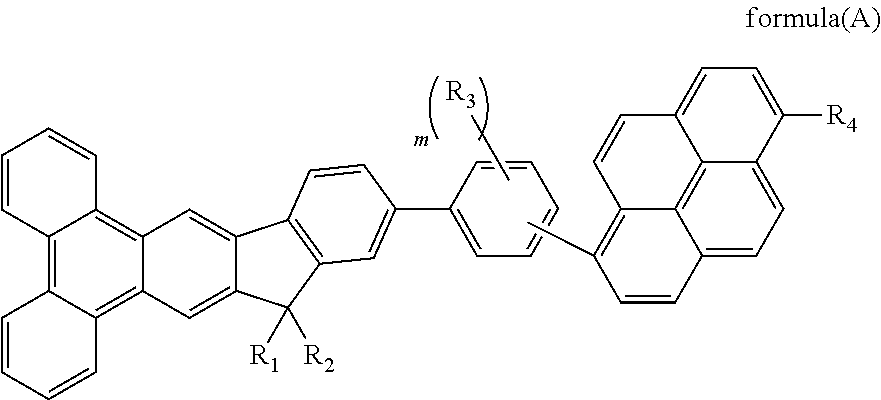Material for organic electroluminescent device
a technology of organic electroluminescent and material, which is applied in the direction of thermoelectric devices, organic semiconductor devices, other domestic articles, etc., can solve the problems of unsatisfactory use practice of blue emitting materials for shorter half-life time and higher driving voltage, and achieve shorter half-life time, higher driving voltage and power consumption, and shortening the effect of half-life tim
- Summary
- Abstract
- Description
- Claims
- Application Information
AI Technical Summary
Benefits of technology
Problems solved by technology
Method used
Image
Examples
example 1
Synthesis of Compound A-1
Synthesis of 2-(biphenyl-2-yl)-7-bromo-9,9-dimethyl-9H-fluorene
[0016]
[0017]A mixture of 35.2 g (100 mmol) of 2,7-dibromo-9,9-dimethyl-9H-fluorene, 21.8 g (110 mmol) of biphenyl-2-ylboronic acid, 2.31 g (2 mmol) of tetrakis(triphenylphosphine)palladium, 75 ml of 2M Na2CO3, 150 ml of EtOH and 300 ml toluene was degassed and placed under nitrogen, and then heated at 100° C. for 12 h. After finishing the reaction, the mixture was allowed to cool to room temperature. The organic layer was extracted with ethyl acetate and water, dried with anhydrous magnesium sulfate, the solvent was removed and the residue was purified by column chromatography on silica (hexane-dichloromethane) to give product (26.8 g, 63.0 mmol, 63%) as a white solid. 1H NMR (CDCl3, 400 MHz): chemical shift (ppm) 7.61 (d, J=7.8 Hz, 1H), 7.55˜7.53 (m, 2H), 7.49˜7.42 (m, 5H), 7.29 (d, J=8.0 Hz, 1H), 7.20˜7.14 (m, 5H), 6.98 (s, 1H), 1.21 (s, 6H)
Synthesis of 12-bromo-10,10-dimethyl-10H-indeno[1,2-b]...
example 2
Synthesis of Compound A-5
Synthesis of 1-(5-methoxybiphenyl-2-yl)pyrene
[0026]
[0027]A mixture of 11.1 g (42.4 mmol) of 2-bromo-5-methoxybiphenyl, 10.43 g (42.4 mmol) of pyren-1-ylboronic acid, 0.5 g (0.424 mmol) of tetrakis(triphenylphosphine)palladium, 32 ml of 2M Na2CO3, 80 ml of EtOH and 160 ml toluene was degassed and placed under nitrogen, and then heated at 90° C. for 24 h. After finishing the reaction, the mixture was allowed to cool to room temperature. The organic layer was extracted with ethyl acetate and water, dried with anhydrous magnesium sulfate, the solvent was removed and the residue was purified by column chromatography on silica (hexane-dichloromethane) to give product 12.4 g (76%) as a white solid.
Synthesis of 6-(pyren-1-yl)biphenyl-3-ol
[0028]
[0029]In a 1000 ml three-necked flask that had been degassed and filled with nitrogen, 12.4 g (32.2 mmol) of 1-(5-methoxybiphenyl-2-yl)pyrene was dissolved in anhydrous dichloromethane (200 ml), the solution was cooled to −78°...
example 3
Synthesis of Compound A-13
Synthesis of 1-bromo-6-(naphthalen-1-yl)pyrene
[0034]
[0035]A mixture of 18 g (50 mmol) of 1,6-dibromopyrene, 8.6 g (50 mmol) of naphthalen-1-ylboronic acid, 0.6 g (0.5 mmol) of tetrakis(triphenylphosphine) palladium, 38 ml of 2M Na2CO3, 100 ml of EtOH and 200 ml toluene was degassed and placed under nitrogen, and then heated at 90° C. for 24 h. After finishing the reaction, the mixture was allowed to cool to room temperature. The organic layer was extracted with ethyl acetate and water, dried with anhydrous magnesium sulfate, the solvent was removed and the residue was purified by column chromatography on silica (hexane-dichloromethane) to give product 8 g (40%) as a white solid.
Synthesis of 12-(4-bromophenyl)-10,10-dimethyl-10H-indeno[2,1-b]triphenylene
[0036]
[0037]A mixture of 6.6 g (28 mmol) of 1,4-dibromobenzene, 15.1 g (32 mmol) of 2-(10,10-dimethyl-10H-indeno[1,2-b]triphenylen-12-yl)-4,4,5,5-tetra methyl-1,3,2-dioxaborolane, 0.32 g (0.28 mmol) of tetrak...
PUM
| Property | Measurement | Unit |
|---|---|---|
| temperature | aaaaa | aaaaa |
| temperature | aaaaa | aaaaa |
| thickness | aaaaa | aaaaa |
Abstract
Description
Claims
Application Information
 Login to View More
Login to View More - R&D
- Intellectual Property
- Life Sciences
- Materials
- Tech Scout
- Unparalleled Data Quality
- Higher Quality Content
- 60% Fewer Hallucinations
Browse by: Latest US Patents, China's latest patents, Technical Efficacy Thesaurus, Application Domain, Technology Topic, Popular Technical Reports.
© 2025 PatSnap. All rights reserved.Legal|Privacy policy|Modern Slavery Act Transparency Statement|Sitemap|About US| Contact US: help@patsnap.com



